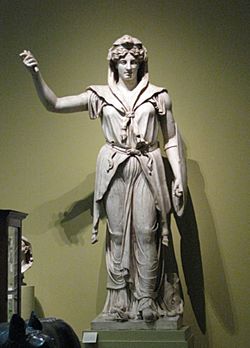Juno (mythology) facts for kids
Quick facts for kids Juno |
|
|---|---|
| Goddess of marriage and childbirth | |
| Member of the Capitoline Triad | |

Juno Sospita, a plaster cast based on an original in the Vatican Museums
|
|
| Other names | Regina ("Queen") |
| Personal information | |
| Consort | Jupiter |
| Children | Mars, Vulcan, Bellona, Juventas |
| Parents | Saturn |
| Siblings | Jupiter, Neptune, Pluto, Vesta, Ceres |
| Greek equivalent | Hera |
| Etruscan equivalent | Uni |
Juno was a very important Roman goddess. She was known as the protector and special helper of the Roman state. Juno was the daughter of Saturn. She was also the wife of Jupiter, who was the king of the gods. Her children included Mars, Vulcan, Bellona, and Juventas.
Juno is like the Hera of Greek mythology, who was the queen of the Greek gods. Just like Hera, Juno's special animal was the peacock. The Etruscans, an ancient people in Italy, called her Uni. Juno was also believed to watch over the women of Rome. As a patron goddess of Rome and the Roman Empire, Juno was called Regina, meaning "Queen." She was part of a special group called the Capitoline Triad. This group included her, Jupiter, and Minerva, the goddess of wisdom. They were honored on the Capitoline Hill in Rome. Juno is also the goddess of marriage. Many people still think that June, the month named after her, is the best time to get married.
Juno's Many Roles
Juno was a very complex goddess. She had many different names and titles. Each name showed a different part of her personality or a different role she played. For example, she was connected to ideas like strong life force, lots of energy, and staying young forever. Scholars today still discuss all the different meanings of Juno.
Juno's Warlike Side
Juno also had a strong, warlike side. This was clear from how she was often shown. She was usually pictured wearing armor and a cloak made of goatskin. This look was similar to the Greek goddess Athena. Athena also wore a goatskin or a goatskin shield called the 'aegis'. This shows that Juno was not just a goddess of marriage. She was also a powerful protector.
Images for kids
-
Juno-Hera, an old painting from Pompeii
-
Juno's sacred geese warn the Romans as the Gauls approach the Capitol in 390 BC
-
IVNO REGINA ("Queen Juno") on a coin celebrating Julia Soaemias
-
Ancient Roman four-gods-stone (3rd century AD) with relief of Iuno or Minerva from Place Kleber. Archaeological Museum, Strasbourg
See also
 In Spanish: Juno (mitología) para niños
In Spanish: Juno (mitología) para niños







